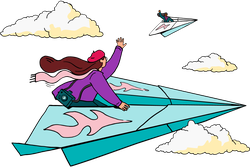
How fostering collaboration can boost innovation

Written by

Global Senior Director of Customer People Science at Culture Amp
The economy is constantly changing, which requires companies to build workforces with continually evolving skills. The past three major economic eras were built on skills for standardizing and scaling repetitive labor.
The eras of the physical economy, the agricultural and industrial economies, emerged when innovations in husbandry and machinery allowed us to reliably mass produce food, shelter, and consumer products. On the other hand, the service economy emerged when computers and telecommunications allowed for the scaling of repetitive mental labor to create reports, provide customer service, and other repeated uses of mental and social skills.
We are now moving into a completely new era built on mass production, not of goods or services, but of innovation itself. Our challenge in this new idea economy is to consistently innovate better uses of our mass production and distribution networks.
We need employees to disrupt old ideas, create new possibilities and then use that massive productive capacity to make those ideas profitable. Perhaps that’s why PWC’s 20th annual CEO Survey found that innovation was the #1 CEO business priority. However, scaling innovation is nothing like scaling the physical and mental labor of past eras. We'll look at how collaboration impacts innovation, including challenges and best practices for making it work in your organization.
Research on collaboration and innovation
Demanding that people innovate harder doesn’t result in better ideas. In fact, it has the opposite effect, as stress inhibits cognitive capacity, and creativity, and prompts people to revert to old habits and routines. This is probably why 77% of CEOs in the PWC study struggle to find the creativity and innovation skills they need. Innovation isn’t something that you can just demand people provide at the moment.
To foster greater innovation, companies are turning to collaborative work where employees pool their knowledge and perspectives to learn and innovate faster.
Research shows that collaboration produces value. In a 2015 study by Google, more than half (56%) of the executives surveyed ranked a collaboration-related measure as the #1 factor impacting their organization’s overall profitability. Work by Nielsen shows that ideas developed by teams of three or more people have 156% greater appeal with consumers than those developed by teams where just one or two people have played a hands-on role. Meanwhile, academic research out of Stanford University has shown that collaborative work fuels intrinsic motivation driving people to stick with their tasks longer, have higher engagement, lower fatigue, and higher success rates than those expecting to work independently.
The challenges of collaboration
However, many leaders and employees find collaboration difficult. Their training and skill sets are attuned to the repetitive labor of the previous eras leading to their struggles in this new idea economy. Employees need several skills to facilitate and act upon collaboration opportunities. These include:
- Time management and coordination skills to keep meetings efficient and effective
- Conflict management skills to foster open, two-way feedback even when employees of different levels of authority and expertise disagree
- Emotional intelligence to build trust so employees will share, not hoard, information
Leaders must also frequently recalibrate how they reward team effectiveness and individual performance. Too much team focus, and you encourage free riders to benefit from colleagues' hard work. Too much focus on individual performance, and employees view team efforts as detracting from their personal rewards and opportunities.
These gaps are not going away on their own.
Organizations need to confront the collaborative skill gaps head-on to foster the innovation they need to dominate their respective markets. To do so, they need swift, intuitive, and effective methods of measuring and fostering collaboration.
How to measure and improve collaboration
Culture Amp customers use our platform to measure the collaborative cultures in their organizations to see if they need to tune up their collaboration skills. Our standard engagement survey template provides three key items for measuring collaboration:
- Other departments at [company] collaborate well with us to get the job done
- Most people here make a good effort to consult other staff where appropriate
- At [company] there is open and honest two-way communication
Customers interested in deep dives into collaboration can work directly with our people scientists to develop more detailed items based on well-supported research from applied and academic sources. Anyone can attend our events, where we discuss the science behind collaboration, generational differences, and techniques for giving and receiving feedback.
Taking action on collaboration
Those that find their survey scores falling below one of our relevant benchmarks or who fail to hit their personal goals can take a tour of the inspirations from our community, who have graciously shared the practices that have improved their scores.
For example, one customer disappointed with employee perceptions of two-way communication at their company instituted a “No-triangles rule.” This rule encourages employees to be upfront and honest with one another. It states that if you have feedback, you must go directly to them and not to a third party. Everyone has permission to call someone out on the rule to embed it into the social norms of the team.
Another customer who found that their employees did not feel that “most people here make a good effort to consult other staff where appropriate” began conducting project service announcements (PSAs). These PSAs inform the organization of a new project kicking off and ask stakeholders to provide relevant background information or necessary resources. The program ensures the right people are being consulted and historical context is given before starting a project.
Commercial success requires organizations and employees to adapt to the economic eras they find themselves in. For your organization to thrive, it must navigate the rise of the idea economy and scale up its innovative practices and collaborative cultures.




